The discussion around All-In-One (AIO) CPU coolers versus custom loops will always be ongoing. However, recently there has been a lot of innovation in the AIO market by manufacturers to try to match the performance and customizability of custom loops. Corsair, not to be outdone by its competitors, is launching its next-generation AIO CPU cooler, the iCUE LINK Titan RX RGB. The Titan combines Corsair's latest advancements in cooling engine technology, replaceable pump caps, and iCUE LINK RX120 fans in hopes of being your next CPU cooler.
In addition to the Titan AIO, Corsair supplied me with three of its CapSwap modules. This review will examine the iCUE LINK LCD Screen, VRM Fan, and Pump Cap Groove modules. Is the Titan good enough to topple another AIO I've recently reviewed, the Cooler Master 360 Ion? Continue reading to find out.
 Howdy, howdy! Mr. Fox here, and today I have the privilege of reviewing yet another wonderful product from our friends at Corsair. As a global leader in the development and production of world-class technology and gear focused on PC enthusiasts, gamers and content creators, CORSAIR needs no introduction. Their ever-growing ecosystem of products do need an introduction, and they were kind enough to send us a new memory kit to put through the paces.
Howdy, howdy! Mr. Fox here, and today I have the privilege of reviewing yet another wonderful product from our friends at Corsair. As a global leader in the development and production of world-class technology and gear focused on PC enthusiasts, gamers and content creators, CORSAIR needs no introduction. Their ever-growing ecosystem of products do need an introduction, and they were kind enough to send us a new memory kit to put through the paces.
Why Should We Care About DDR5?
Before we turn our focus to the product, let’s pause for a moment to answer this question. The answer is fairly simple. As processors continue to increase in core count, PC users are able to do more tasks simultaneously with their computer. For example, a person might be gaming on one display, streaming that game with overlays on another display, interacting with their audience and doing other things in the background like playing music. All of this activity takes bandwidth, speed and memory capacity. And, that kind of scenario is one way this kit of CORSAIR VENGEANCE RGB DDR5 memory can take your experience to the next level.
Under the hood there are some other changes that also matter. DDR5 requires less power than DDR4. Reference VDD has dropped from 1.200V to 1.100V with the generational advancement and the voltage regulation has moved from the mainboard to the memory module, on what is known as a “power management integrated circuit” or more commonly referred to as the PMIC. This can have benefits in terms of not only efficiency, but overclocking.
So, let’s get down to brass tacks, shall we?
The Product – What CORSAIR Wants Us to Know
CORSAIR VENGEANCE RGB DDR5 memory delivers DDR5 performance, higher frequencies, and greater capacities optimized for Intel motherboards while lighting up your PC with dynamic, individually addressable ten-zone RGB lighting. Tightly screened high-frequency memory chips enable faster processing, rendering, and buffering than ever, with onboard voltage regulation for easy, finely controlled overclocking. Take control with CORSAIR iCUE software and enable RGB lighting customization, real-time frequency monitoring, onboard voltage regulation, and Intel XMP 3.0 profile customization. A custom PCB provides superb signal quality for high performance and stability on the latest Intel DDR5 motherboards. For cutting-edge DDR5 performance with mesmerizing RGB lighting, VENGEANCE RGB DDR5 lights the way.
Key Features
- Cutting-Edge of Performance: Push the limits of your system like never before with CORSAIR DDR5 memory, unlocking even faster frequencies, greater capacities, and higher CPU processing.
- Dynamic Ten-Zone RGB Lighting: Illuminate your system with ten individually addressable, ultra-bright RGB LEDs per module, encased in a panoramic light bar for vivid RGB lighting from any viewing angle.
- Onboard Voltage Regulation: Enables easier, more finely-tuned, and more stable overclocking through CORSAIR iCUE software than previous generation motherboard control.
- Custom Intel XMP 3.0 Profiles: Customize and save your own XMP profiles via iCUE to tailor performance by app or task for greater efficiency.
- Create and Customize: Choose from dozens of preset lighting profiles, or create your own in iCUE.
- Maximum Bandwidth and Tight Response Times: Optimized for peak performance on the latest Intel” DDRS motherboards.
- Custom Performance PCB: Provides the highest signal quality for the greatest level of performance and stability.
- Tightly Screened Memory: Carefully screened memory chips for extended overclocking potential.
- Stylish Solid Aluminum Heat Spreader: Efficiently conducts heat away from your memory, with refined VENGEANCE styling to fit the look of modern systems.
- Limited Lifetime Warranty: For complete peace of mind.
Vengeance DDR5 RGB Product Line Technical Specifications
| FEATURE | DESCRIPTION |
|---|---|
| Kit Densities | 32GB (2x16GB) & 64GB (2x32GB) |
| Speeds | DDR5-5200, DDR5-5600, DDR5-6000, DDR5-6200, DDR5-6400, DDR5-6600 |
| Module Format | UDIMM - 135 x 8 x 56mm |
| Voltage | 1.1V - 1.4V |
| LED Type | Individually Addressable RGB LEDs |
| LED Count | 10 |
| Software Control | CORSAIR iCUE v4.26 or newer |
| Pin Out | 288 Pin UDIMM |
| XMP | Intel XMP 3.0 |
| Heat Spreader | Aluminum (available in Black or White) |
| Compatibility | Intel 600 Series Chipset |
| Warranty | Limited Lifetime |
Review Kit Technical Details – What ExtremeHW Wants You to Know
The kit provided for today’s review is a single rank module configuration using Samsung IC. Please note that the IC brand may vary based on SKU number. The SKU for the memory kit under review is CMH32GX5M2D6000C36, sporting the black heat spreader. It is available for purchase directly from CORSAIR for $279.99 USD or €359.99 EUR at the time of this review.
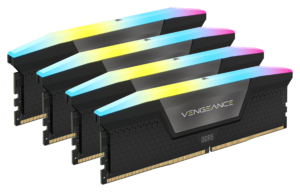
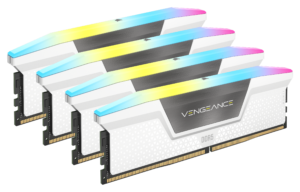
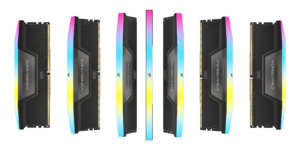

(click any of the above images to enlarge for viewing)
As we have already discovered, Thaiphoon Burner needs to be updated for DDR5 compatibility. Thus, we will rely on what we can see using other tools available to us at the time of this review. We can see from the detail in CPU-Z and AIDA64, our review kit sports a default XMP 3.0 profile that operates at 6000 MT/s with latency timings of 36-36-36-76 (CL-RCD-RP-RAS) using 1.350V. It is worth noting how many timing configurations are provided by CORSAIR in each speed bin. This is important for motherboard and processor compatibility. I can tell you from looking at the AIDA64 data that the coverage is much broader than what is offered in a competitor’s brand I was using prior to this review.
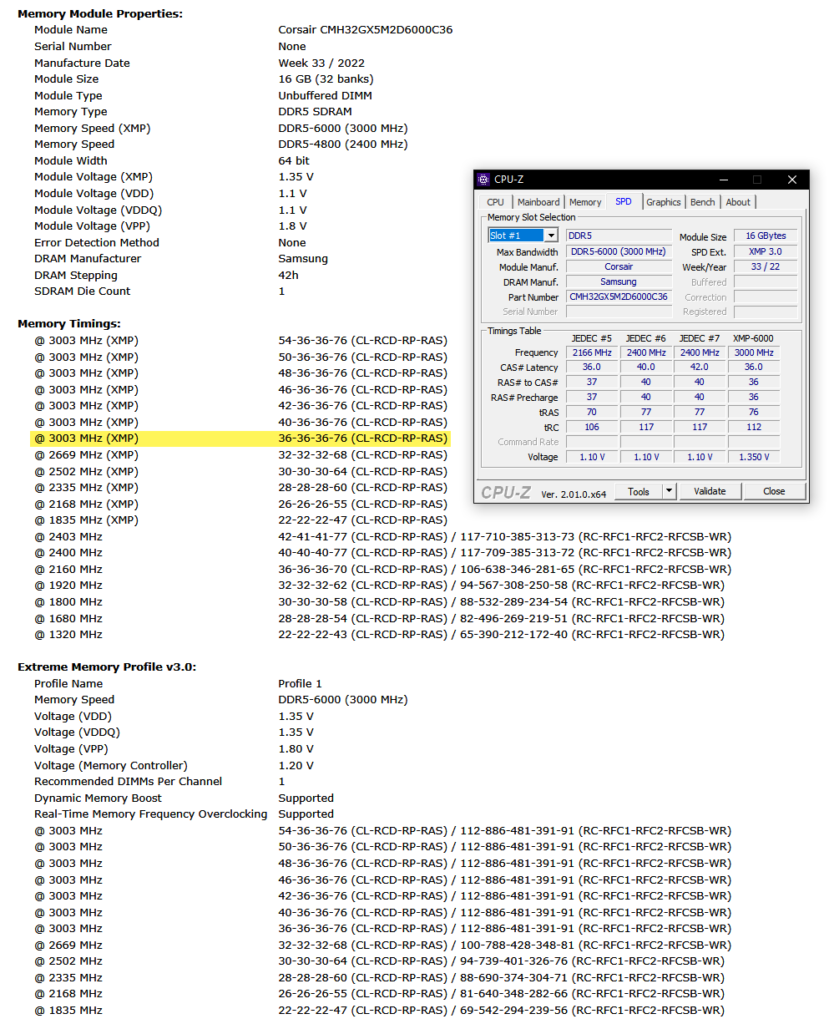
Retail Packaging and Initial Impressions
CORSAIR always does an excellent job of packaging their products in an appealing manner. While this contributes nothing to functionality or performance, it says a great deal about the company. It speaks to the pride they take in their brand, the product on offer, and the impression that makes on the customer. We see no exception to that rule here. The retail packaging is an attractive yellow with adequate information to identify the contents. The modules are protected in the typical clear plastic clamshell jacket and there is an accompanying “Safety Information” sheet as required for regulatory compliance. I will say that I like the fact that the plastic jacket is not sealed. It snaps closed and you can open the packaging without a need for cutting things apart. Should you ever need to store or ship the memory at a later date, you will appreciate that as much as I do.
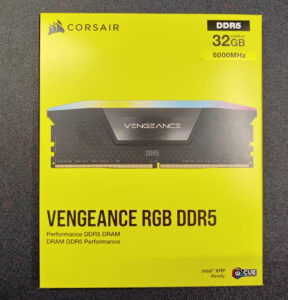
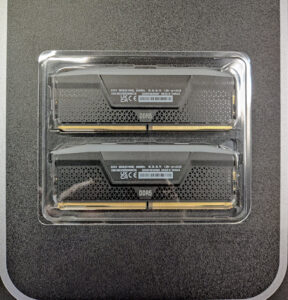
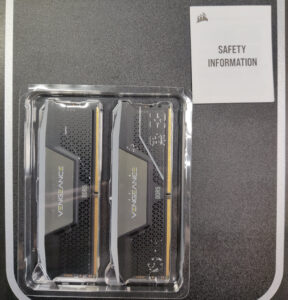
(click any of the above images to enlarge for viewing)
Subjectively, the memory modules look gorgeous. The color, texture and overall aesthetic is excellent and very tasteful. They compliment the Z690 Dark Kingpin motherboard and provide a dramatic impression. The RGB lighting is easily managed using iCUE software readily available for download from CORSAIR.
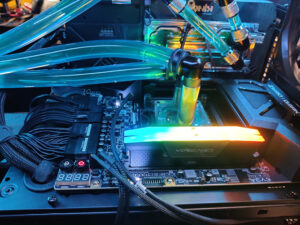
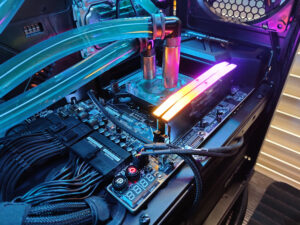
(click either of the above images to enlarge for viewing)
On an objective note, we observe that the modules are a low profile design. This will be very useful if you are building a system with an air cooler that overhangs the memory modules. The risk of interference with the air cooler or its fan should be slim to none with these beauties. The jacket and RGB diffuser do not extend beyond the outer boundaries of the memory slots at either end, which should also minimize interference with GPUs using an actively-cooled backplate, or a top mounted radiator and fan assembly when installed in a case lacking thoughtful design. We have seen examples from a few memory vendors where the memory module heat spreaders and RGB diffusers had odd shapes that take up extra space unnecessarily. This may look fancy to some, but it creates headaches where space is a concern. It is safe to say CORSAIR does a great job of making that a non-issue with these bad boys.
RGB Feature Set and iCUE Software
If RGB is something that gets you excited, then buckle up. There is so much more to iCUE than changing the color scheme of your memory modules.
The next evolution in CORSAIR iCUE software has arrived, and with it comes the opportunity for turning your entire setup into a cohesive, immersive ecosystem with intuitive controls. iCUE lets you synchronize the RGB lighting across all your compatible CORSAIR devices for a system-wide light show like no other. That is not where your ride ends. And you buckled in yet? Things are about to get personal.
Personal, as in personalized and intimate with your PC. iCUE allows you to monitor real-time temperatures, set custom lighting effects to alert you if your temps start running high, and create fan curves to automate the adjustment of fan speeds. Additionally, you can create custom profiles that adjust performance based on your activity. You can make a quiet mode for focusing on work, or a max performance mode for gaming at high settings or your overclocked benching sessions, or anything in-between. Your only limits are your imagination.
But, wait! There is even more now. The latest version of iCUE includes exclusive game integration features. CORSAIR have partnered with select game studios to enable functionality that turns your pride and joy into a source for fully immersive gaming, with lighting automatically synched to the context of in-game action.
GET INSPIRED – iCUE offers virtually limitless customization, from the components inside your case to the lighting in your room. Looking for some creative inspiration? Check out our favorite setups from users just like you!
SIMPLE CONVENIENCE – With just a single interface for every device, iCUE delivers simplified control over a massive range of CORSAIR and supported partner products.
iCUE CERTIFIED PARTNERS – CORSAIR partners with trusted system builders around the world who will custom build an iCUE-certified PC for you using award-winning CORSAIR components.
After you are finished with this review, you will find a link at end to jet you over to the CORSAIR YouTube channel to check out the 31 (no, that is not a typo… thirty-one) video tutorials they offer that guide you through exploiting every feature imaginable.
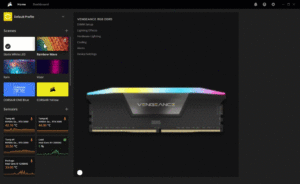
It is worth mentioning that my initial experience with iCUE was frustrating. It would install without error, but it offered no functionality whatsoever with respect to RGB control. In fact, iCUE was not able to detect the CORSAIR VENGEANCE RGB DDR5 memory modules installed in my system. I thought the memory had a defect, but CORSAIR informed me that I needed to find “SPD Write Enable” in the BIOS and activate it. I knew exactly what option they were referring to, as it needs to be enabled for SPD flashing and memory firmware mods.
The default setting is “disabled” and, unfortunately, not all motherboard manufacturers support that. Some view it as a security risk and do not afford their customers the autonomy to decide for themselves whether risk is worth reward. CORSAIR is working on an update to iCUE that will address this functional limitation for PC owners that have unknowingly purchased a system missing important enthusiast-centric firmware features. Flipping this BIOS option to enabled immediately allowed iCUE to function on my EVGA Z690 Dark Kingpin motherboard. Sadly, my MSI MEG Z690 Unify-X did not have this BIOS option, or it was buried in an obscure menu location with an obfuscated label.
As soon as I had it working, I made a bee-line for the RGB area of the iCUE interface and changed my memory lighting to static white. Perhaps I am dating myself, but the animated RGB rainbow puke-fest that has become the official default for virtually all RGB products on the market just doesn’t give me any warm fuzzy feelings. But, I do love the added lighting it brings to an otherwise dark and gloomy cavern. And, man… the LEDs on these bad boys are bright! Thankfully, CORSAIR even went as far as including an LED brightness adjustment feature in iCUE.
Stability Testing and Performance Results
By now you might be saying, “Goodness gracious, Fox… enough of the fluff already, show me the numbers for Pete’s sake!” Lest I bore you with more mumbo-jumbo, let’s jump to the part that some of us care about most.
Testing was performed on two motherboards and CPU configurations. Where applicable, results will be reported separately for the sake of clarity.
- Configuration #1 – MSI MEG Z690 Unify-X – BIOS vA.60
- Intel Core i9-12900KS @ 54x P-Cores, 43x E-Cores, Cache 46x
- VCore 1.335V (Override)
- SA, VDDQ, VDD2, AUX voltage vary by mainboard and memory overclock settings
- Windows 10 Enterprise LTSC 2019 (1809)
- Configuration #2 – EVGA Z690 Dark Kingpin – BIOS v1.14
- Intel Core i9-12900K @ 54x P-Cores, 43x E-Cores, Cache 46x
- VCore 1.380V (Override)
- SA, VDDQ, VDD2, AUX voltage vary by mainboard and memory overclock settings
- Windows 10 Enterprise LTSC 2021 (21H2)
- Chassis, GPU, PSU and Cooling System (applicable to both configurations)
- EVGA RTX 3090 Kingpin Hydro Copper
- EVGA SuperNova 1600 P2 PSU
- Case – Thermaltake Level 20 XT, 4x200mm intake fans, 1x120mm exhaust fan
- OptimusPC Foundation CPU block, MO-RA 360 Pro radiator, 3xD5 Pumps
- Ambient Temperature – 73.0~75.0°F
Thermal Testing
Thermal testing was conducted on Configuration #1. This test consisted of running MemTestPro with the DangWang 5.0.2860 GUI for 100% coverage and a duration of 35 minutes. This test was run using the XMP profile defaults. No auxiliary fan was used to enhance air circulation over the memory modules.
- DIMM #1 – 67.8°C Maximum
- DIMM #2 – 65.5°C Maximum
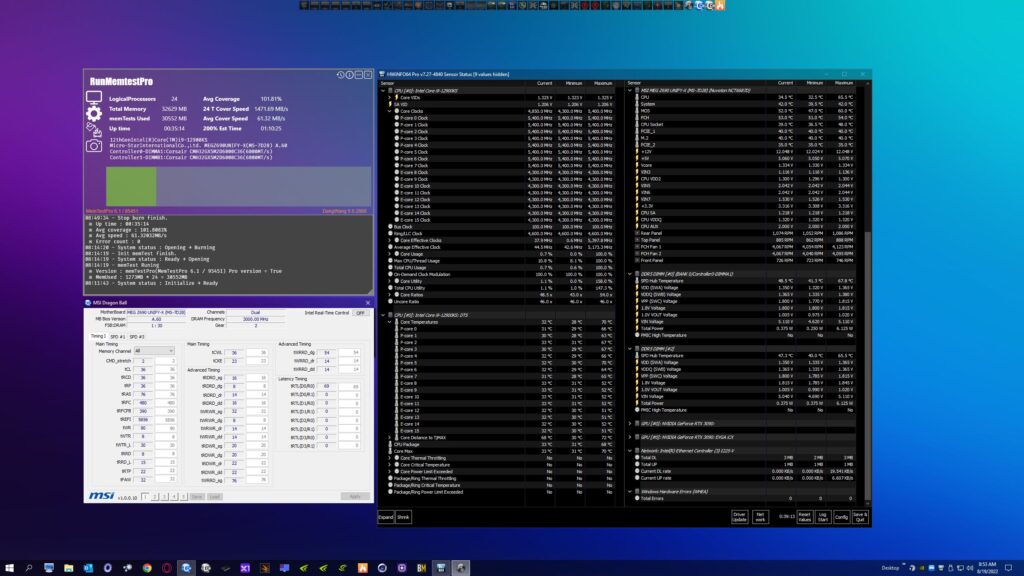
Thermal testing was conducted on Configuration #2. This test consisted of running TestMem5 v0.12 with the @Ollie configuration file. The test duration was 19m 20s duration. This test was run using the XMP profile defaults. No auxiliary fan was used to enhance air circulation over the memory modules.
- DIMM #1 – 64.0°C Maximum
- DIMM #2 – 64.5°C Maximum
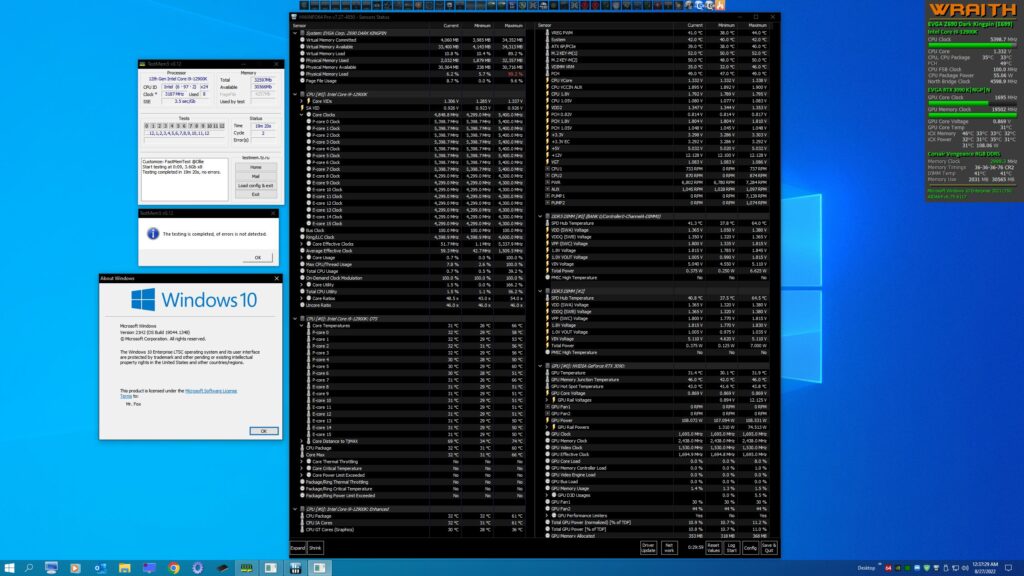
Performance Testing
Performance testing consisted of running the default CORSAIR XMP profile on each system and capturing results. Stability of the XMP profile was already verified in the portion of the review relating to thermals. The overclocking capabilities involved increasing memory voltage to 1.435V and increasing the memory clock multiplier by 200 MT/s increments, but not altering any of the timings. The intent in not altering any of the timings was to avoid discrepancies between firmware and motherboard overclocking capabilities while finding the maximum stable overclock speed based on the multiplier. After all, this is a review of the memory and not the other components.
CORSAIR VENGEANCE XMP Profile Defaults
Performance testing was conducted on both configurations using the XMP default values. It is interesting to note a small variance in performance between the systems using XMP defaults. The difference is considered to fall within a normal margin of error, but the best of three run showed memory read, write, copy and latency was better with the EVGA Z690 Dark motherboard.


Overclock Testing – 6200 MT/s
For this test, the clock multiplier was increased to 6200 and memory voltage increased to 1.435V on each system. Again, it is interesting to note performance leaned in favor of the Kingpin motherboard. It was necessary to increase VPP from default 1.800V to 1.900V on the Kingpin motherboard to avoid Windows freezing during the benchmark. That was not necessary on the Unify-X. While only speculation, it is suspected that the “Auto” setting on the Unify-X adjusted the VPP more effectively and avoided the need for user intervention.

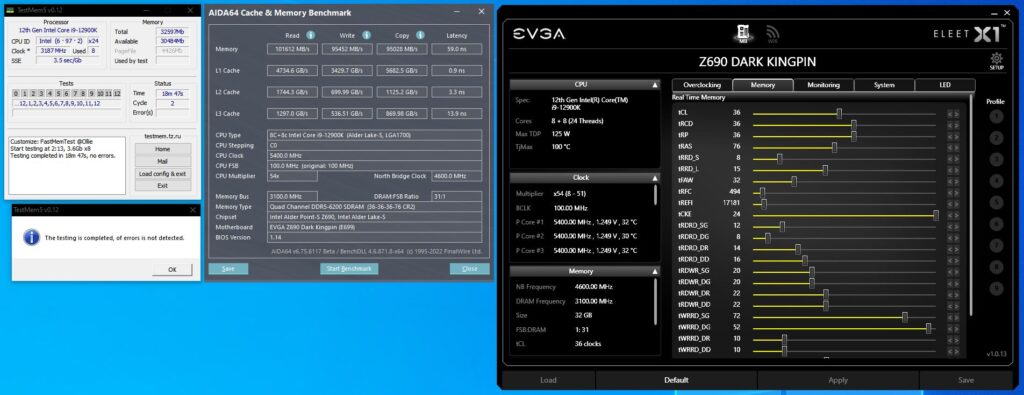
Overclock Testing – 6400 MT/s
For this test, the clock multiplier was increased to 6400 and memory voltage remained 1.435V on each system. On the MSI system TM5 began to produce errors because of overheating. Placing a 120mm fan over the modules lowered the temperatures significantly and the TM5 errors went away. The memory did not overheat as severely on the Dark motherboard. It was not necessary to add a fan to avoid TM5 errors. If we look back to the thermal testing section of the review, this was also true running the XMP defaults. An anecdotal explanation could be that the Dark has an actively cooled VRM with two fans blowing cool air into that area drawn in from the rear I/O panel. The module closest to the CPU (and VRM fans) consistently runs just a tad cooler than the module situated on the outer edge of the motherboard. Even so, without an auxiliary fan the memory modules reach undesirable temperatures on the Dark motherboard and errors would be likely in an environment with higher ambient temperatures.
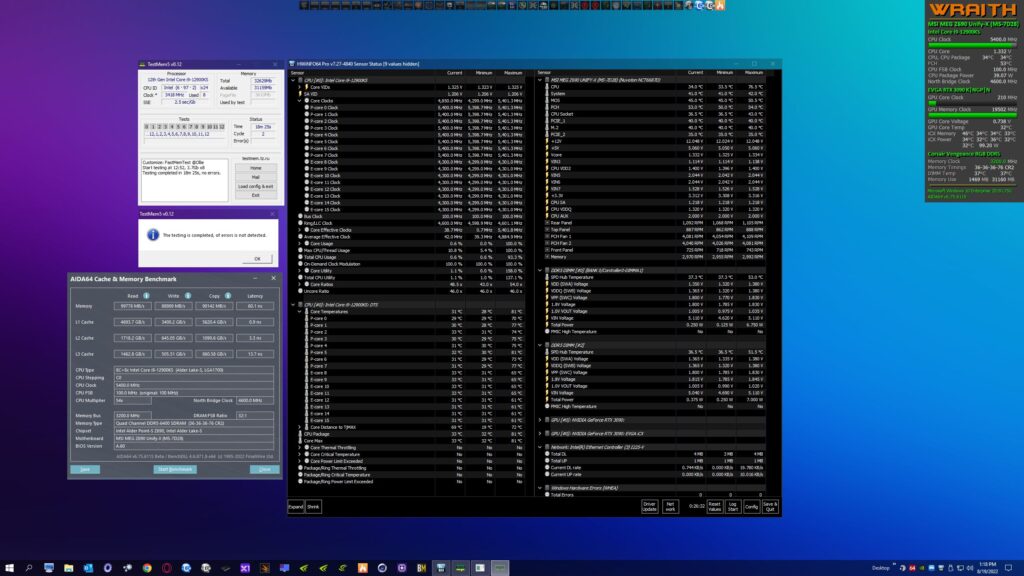
Simply flipping the memory clock from 6200 to 6400 would not work for the Dark motherboard. It would reboot spontaneously during the AIDA64 benchmark due to one of the timings not being optimal. However, using the Dark motherboard’s included Luumi 6400 memory overclock profile for Samsung ICs did work. The test below using that manual overclock shows a dramatic improvement in performance at 6400 MT/s compared to the XMP profile timings. Something in the Luumi profile allowed us to eek a little more than the 1.435V DIMM voltage that was manually set. Using the Luumi 6400 Samsung profile and no helper fan, we see the memory getting uncomfortably warm. I was surprised to see it completing the TM5 test at those temperatures without errors.
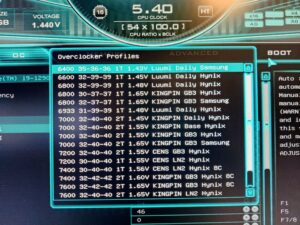
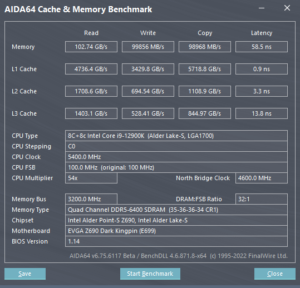
(click either of the above images to enlarge for viewing)
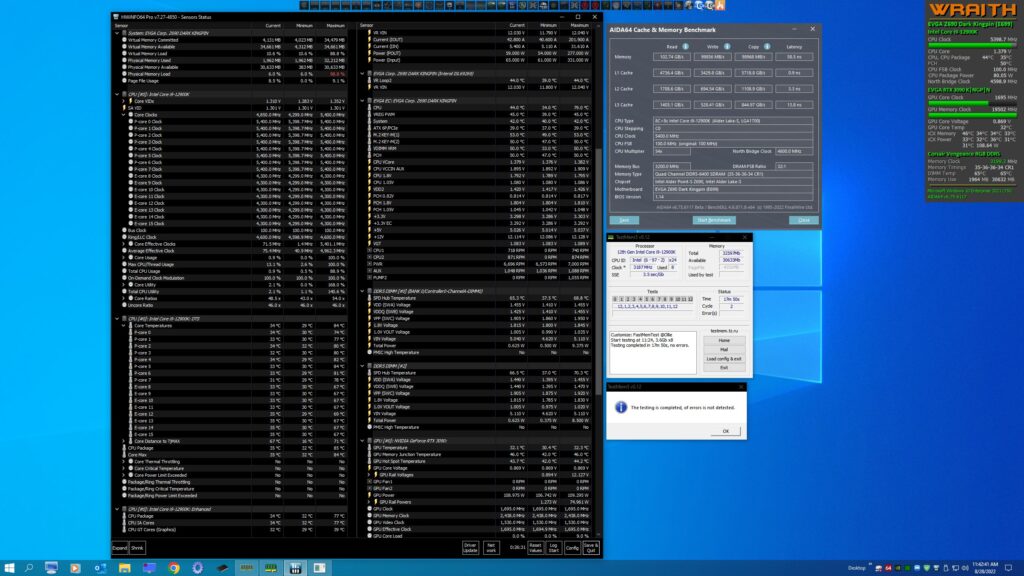
Overclock Testing – 6400 Brick Wall
Sadly, the PMIC on these Samsung-based modules is capped at 1.435V. The Unify-X motherboard had no option to override the lock. The Dark motherboard does have the option, but due to the lock the system will not POST if the cap is manually overridden. Samsung DDR5 ICs are known to be inferior to S.K. Hynix and these modules would need more than 1.435V to pass memory testing without errors above 6400 MT/s. I have tested non-RGB CORSAIR VENGEANCE 6200 modules that are manufactured using S.K. Hynix ICs and they do not have the unfortunate functional limitation that we see with this kit. The S.K. Hynix-based kits tested have all been able to run stable at 6800 or 7000 MT/s with tighter timings and lower voltage than the Samsung IC variants.
Just as this review was preparing to go to publication, EVGA released BIOS update v1.15 for the Z690 Dark that added support for DDR5 Renesas PMIC over 1.435V. Nothing in the published specifications from CORSAIR indicates if this SKU has a Renesas PMIC. Application of this firmware updated did not add overclock functionality and the PMIC on these modules does not allow the system to boot above 1.435V. I tested by increasing the voltage one tick to 1.440V and the system would power cycle on and off with a code 55 and memory LEDs on the motherboard steady red color.
Conclusions and Final Thoughts
CORSAIR has provided a good quality RGB memory kit that looks amazing and will be accommodating for builders using components with space restrictions. Performance is good considering the kit uses Samsung ICs. For most gamers and casual enthusiasts that intend to simply apply an XMP profile and move on to other things, the price is right and the performance delivery is as-advertised.
Overclocking potential is severely limited by the IC and the locked PMIC. What makes that most unfortunate is the fact that many of the popular memory manufacturers, including CORSAIR, make it nearly impossible to know what they are buying. No information is provided in the specifications on the CORSAIR product page or any other documentation I could find. This should not be the case, and the omission of this information in product specifications has been criticized by numerous overclocking professionals in articles and YouTube videos. Some have even gone as far as calling the deliberate omission of this information to be deceptive. I have personally returned numerous memory kits to the place of purchase because they did not have the expected memory IC, including some that had product marketing images depicting the desired IC, but showing up at my door with something different than expected.
We encourage CORSAIR and all of their competitors to publish this crucial detail clearly in the product specifications, and to use unique part numbers to clearly identify what memory IC their customers are purchasing. This transparency will avoid unwelcomed surprises, unnecessary frustration, and reduce the rate of RMAs and retail returns for customers that are not willing to settle for an inferior IC.
Another area of opportunity we are seeing with DDR5 technology in general is inadequate cooling. The heat spreader designs and thermal interface materials being utilized for DDR5 were marginally adequate for overclocked DDR4 modules. We haven’t seen any real improvements in design or materials in most manufacturers’ DDR5 modules. What we saw in this review is generally characteristic of DDR5 modules produced for enthusiasts, and it is not good enough. Additional effort is needed on the development of better thermal management solutions.
In my own situation, I have been faced with having to remove the factory heat spreaders and replace them with better quality interface materials and better heat spreaders to avoid thermally-induced memory errors. The cheap, thin aluminum “beauty shields” that are commonly being passed off as heat spreaders leave a lot to be desired no matter who the manufacturer is. They are not adequate if you plan to run higher memory clocks, tighter timings and additional voltage. I do not know any overclocking enthusiasts that buy high end components with the idea of running them at the manufacturer default settings. People that do that are consumers, not enthusiasts.
Thanks again to our friends at CORSAIR for providing this excellent memory kit for review. So, let’s bring it home with a list of Pros and Cons and seal the deal with the ExtremeHW Award badge!
And, don’t forget to check out the New CORSAIR iCUE (4.X) Tutorials mentioned earlier in this review. You can download iCUE directly from CORSAIR using this link.
| Pro's | Con's | ExtremeHW Award | ||||
|---|---|---|---|---|---|---|
| Excellent Price | Samsung DDR5 IC |  Great Choice for Gamers and Casual Overclockers! |
||||
| Aesthetically Pleasing Design | PMIC 1.435V Cap | |||||
| Stable XMP Performance | Limited Overclocking | |||||
| RGB (if you like RGB) | RGB (if you don't like it) | |||||
| Low Profile Design | ||||||
| Choice of Black or White |
Want to discuss this product or give your views and feedback from your own usage? Discuss on the ExtremeHW Forums
Like our content? Please consider Donating to help us to continue our writing.
This Post Has 4 Comments
Leave a Reply
You must be logged in to post a comment.




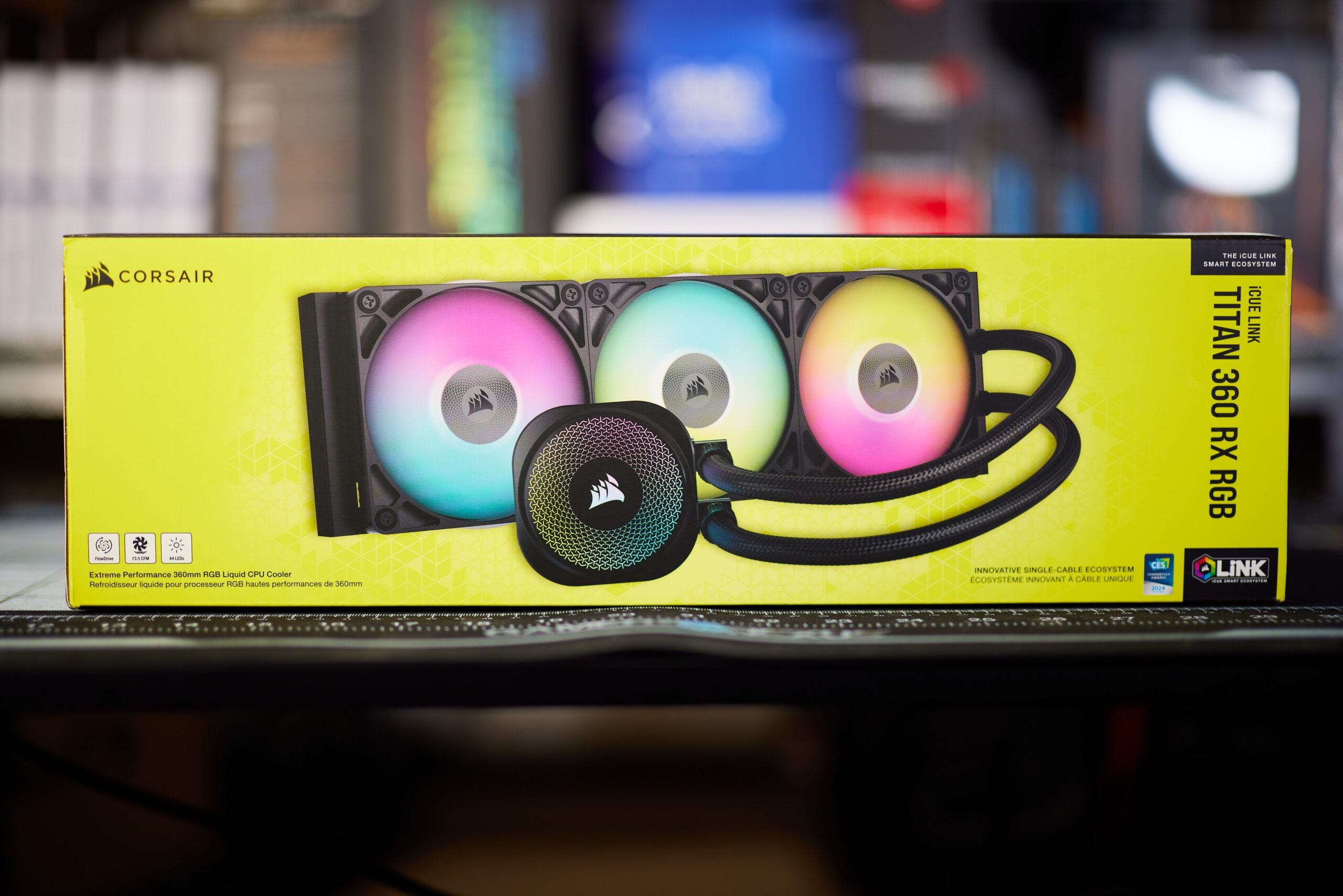
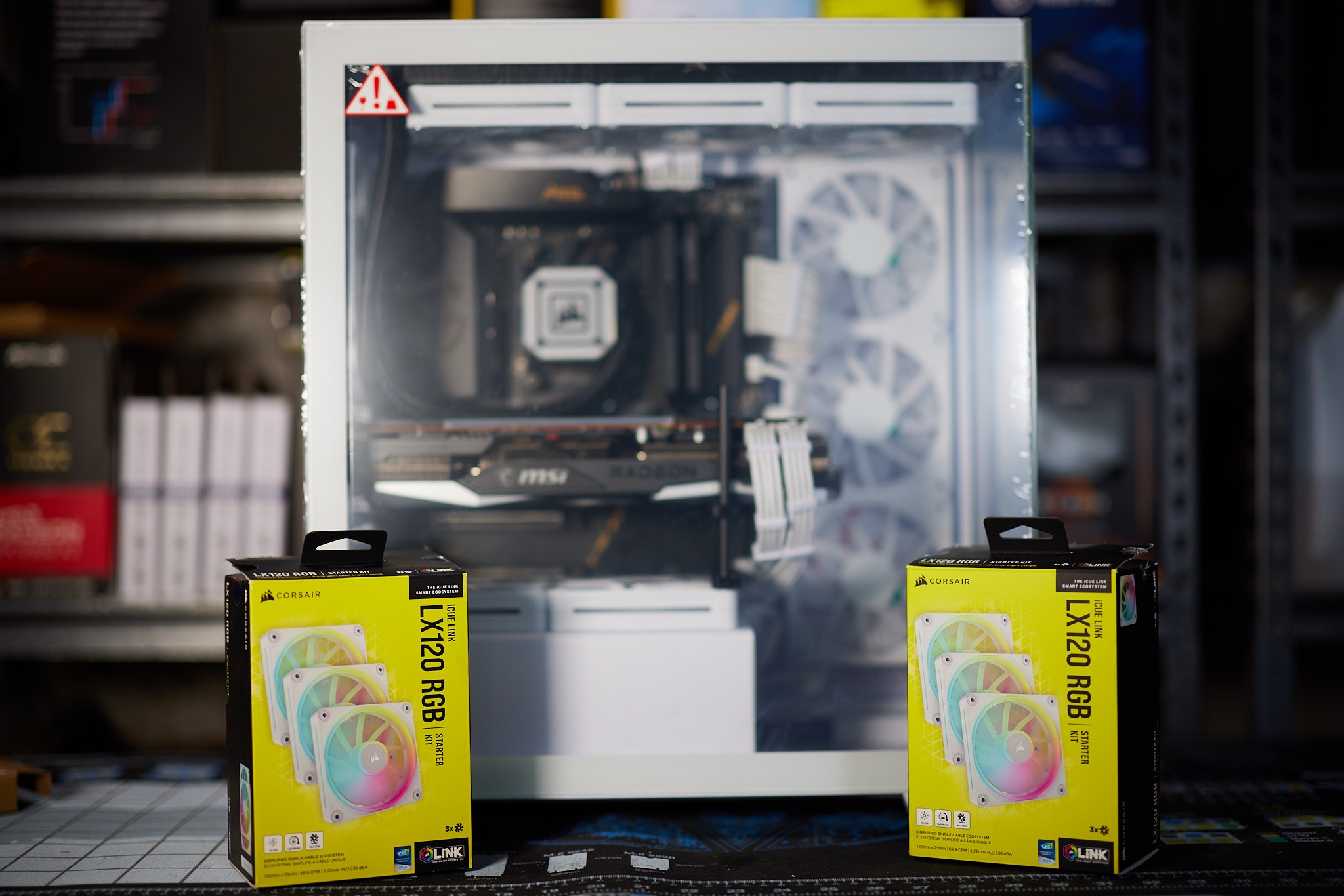
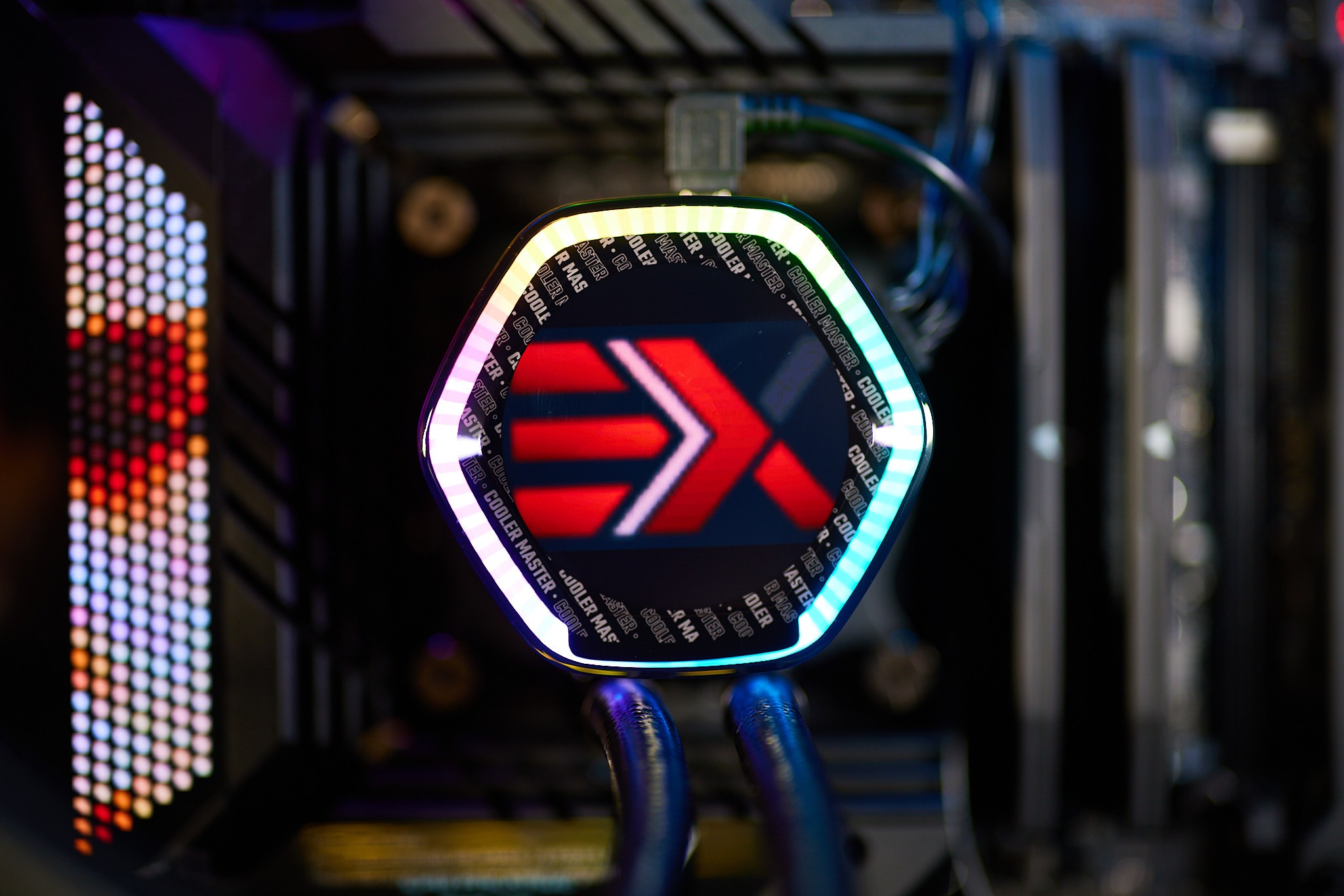
Thanks for the write up, just the right amount of detail and honesty that I have come to expect from Mr. Fox
Thanks for sharing!
Thank you, sir.
Excellent review and content piece Mr. Fox, appreciate all the testing you’ve done here.
Thanks @Talon.